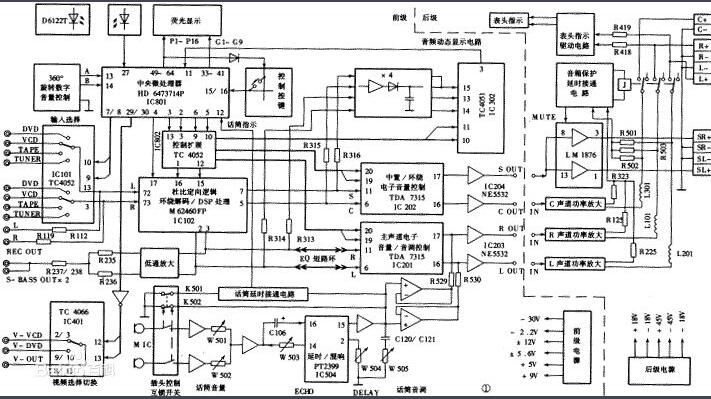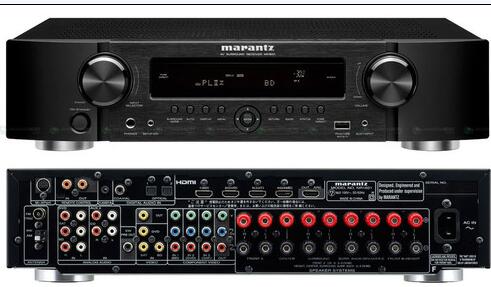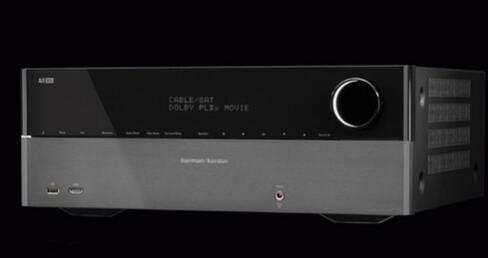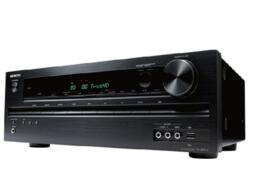AV amplifiers are amplifiers used in audiovisual systems for home theater audiovisual systems with complete amplifiers. AV amplifiers generally have front-end, center-mounted, surround and other 4~7 channel power outputs, some with Dolby Pro Logic Surround Decoder or AC-3 decoder, DSP digital sound field processing, FM/AM digital tuning radio Function, also has a variety of audio input and output interfaces, some power amplifiers and SVIDEO (high definition) video four-pin interface, various functions can be controlled by the remote control, very convenient to use.
This paper first introduces the composition and principle of AV power amplifier, and then answers the question of whether the power amplifier is getting better and better, and the common fake means of AV power amplifier. Finally, it explains how to judge the advantages and disadvantages of AV power amplifier and the factors of purchasing power amplifier. Write a detailed understanding.
The composition and principle of AV amplifierThe AV amplifier, as its name implies, is an amplifier that is used in conjunction with an image source to produce an audiovisual combination, and is designed for the home theater to create a sound field. It uses its internal delay and reverberation processing circuit to control the delay time between channels during playback. By adjusting the length of the delay time, it simulates the sound field in various listening environments, such as halls, churches, stadiums, Studio and so on. AV amplifiers emphasize parameters such as channel isolation, delay time range, and various sound field modes. AV amplifiers have four channels, up to nine channels. Currently, AV amplifiers on the market combine the needs of home playback, mostly five or seven.

The AV system is mainly composed of a large-screen color TV, a DVD player or a high-fidelity video recorder, an AV multi-channel surround amplifier, a center speaker, a pair of main speakers, and a pair of surround speakers. The AV system focuses on the performance of large dynamic effects, which creates a thrilling scene with the atmosphere and the sound field positioning of the picture. People can enjoy the audiovisual effects unique to the cinema at home.
AV multi-channel surround sound systems mainly include Dolby Logic Surround Sound System, THX System, and Yamaha's Cinema CINEMA DSP System. These three systems have their own advantages. Dolby Logic Surround is multi-channel recording. Generally speaking, it is four channels. When recording, use multiple pickups, and arrange them in various directions of the player at different distances. The sound signals will be picked up. After AD becomes digital, these digital codes are encoded according to certain rules, compiled into two-channel digital, and finally recorded on two-channel video. When people want to enjoy the DVD, Dolby logic decoding system converts the digital on the two channels into four-channel or five-channel digital, and then DA conversion, through the AV multi-channel amplifier, respectively sent to several pairs of different The position of the speaker, in order to achieve surround sound, and strive to reproduce the style of live recording. Yamaha's CINEMADSP was developed from Dolby Logic. Fully compatible with Dolby Logic Decode Surround System and has its own unique features. Is the digital sound field processing Yamaha CIN? EMADSP's unique technology. It uses DSP (Digital Signal Processing Chip) and CPU to store parameters of sound field propagation in specific occasions such as wilderness, church, concert hall, canyon, etc., and directly adds the parameters to the surround sound after Dolby logic decoding. It makes up for the lack of Dolby surround sound.
Is the amplifier getting better?The main reason for the power amplifier is not to look at the weight. The misunderstanding that most people fall into is that the output power of the general power amplifier is large. The transformer is large, and the materials used are much larger, so the weight will be heavier. However, weight is not a measure of the quality of the amplifier. The main factor is the output power. The higher the power, the lower the distortion and the better the sound quality, so the price will be higher. For example, if the 25 kg amplifier does not have the sound quality of a 20 kg amplifier, then the price will be lower. Therefore, the power amplifier mainly does not look at the weight but the power and sound quality.

1. For many people who think that the power amplifier is “sinking better and betterâ€, the inferior power amplification uses a toroidal transformer, and many use a double-ring cow with fever. However, the quality of this kind of ring-shaped silicon steel sheet is very poor, and the winding process is not enough. It causes low efficiency and low actual power. Especially when it is quiet, it is easy to hear the ring cows humming.
2. Fill in imported brand-name capacitors with large-capacity domestic capacitors. Some manufacturers even used a backlog of early capacitors to repackage and refill new capacitors. The actual withstand voltage and capacity of these capacitors simply do not reach the nominal value. These types of capacitors are generally lighter than the true ones.
3, low-end 4558 or 082 charge 5532 and other high-end op amps. The editor found that many of the so-called 5532 were actually 4558 polished. There are also domestically produced power amplifier tubes filled with imported tubes, especially Toshiba tubes with the most fakes.
4, poor quality amplifiers often have 5 channels or even 7 channels output. But in fact, many of the amplifier's surround and center channels are connected by the left and right main channel series resistors. Although some amplifiers have independent amplification circuits, they are only subjected to simple delay processing, and there is no dedicated decoding circuit and sound field processing circuit. When identifying such amplifiers, if you find that the surround and center channels cannot adjust the volume separately, it must be a false surround from the main channel series resistor.
If there is a nominal Dolby Pro Logic decoding function and no noise test. Or if the surround speaker rings when only the mono signal is input, the amplifier is a pseudo surround sound amplifier. For amplifiers using technologies such as SRS and Q-Sound, the true and false can also be identified by comparing the audition to turn the surround function on and off and selecting different surround modes. Here, we need to remind everyone that some audio manufacturers have actually adopted the Dolby decoder chip such as M69032, but they have not passed the Dolby certification and also posted the Dolby logo. Such power amplifiers cannot guarantee the necessary performance indicators such as channel separation, and are also counterfeit.
5. Lack of complete protection functions. Although the inferior machine has the function of starting and anti-shock protection, most of the necessary over-current, over-voltage and output DC protection functions are omitted. The reliability of the whole machine is poor, and if there is a problem, it is likely to burn the expensive speaker unit. For the identification of such fake methods, one is to check whether the design has perfect protection function by looking at the circuit diagram. The second is short-circuit short-circuit output, if the amplifier does not appear protection action. It is very likely that these protection circuits have been omitted, at least the tuning is poor.
6, with Class B filling, one-sided pursuit of multi-function and appearance while ignoring the level of circuit design, and as a selling point to blow. This is all about "advanced" fake tricks. For these "characteristic" amplifiers, if consumers are not familiar with audio equipment, it is best to ask people who know how to help, and try to choose a sound manufacturer's products more reliable.

The AV amplifier is the core of audio playback and functions as a multi-channel sound playback function. When it comes to multi-channel playback, it is inseparable from the standard of surround sound. When choosing an amplifier, be sure to pay attention to whether the amplifier has the current popular surround sound standard certification:
1. Dolby Prologic surround sound.
2. Dolby Digital surround sound.
3, DTS surround sound.
4. THX Surround EX surround sound (7.1 channels).
5, DTS-ES Discrete surround sound (6.1 channel) and so on.
A home AV amplifier must have at least the decoding and playback function of Dolby Digital Surround, because Dolby Digital is the mandatory audio standard for PAL DVDs specified by the DVD Alliance in December 1997. Whether the AV amplifier has this function is the user. The basic point of choice. Other certifications are a direct manifestation of this amplifier level.
In addition to the obvious certification, there are many indicators and parameters to evaluate the quality of an AV amplifier.
1. Output power: refers to the energy obtained on the speaker connected to the power amplifier. For the power amplifier, its rated power (the effective value power that can be continuously output under the condition of no distortion) is an effective indicator for evaluating the performance of the power amplifier.
2. Distortion: The output of the device cannot completely reproduce its input. The distortion of the waveform or the increase or decrease of the signal component is called distortion. The smaller the distortion of the power amplifier, the better the sound quality.
3. Dynamic range: The level difference between the strongest part and the weakest part of the signal. For the equipment, the dynamic range indicates the ability of the equipment to respond to strong and weak signals.
4. Damping coefficient: The damping coefficient is the ratio of the load impedance to the output impedance of the amplifier. It is a performance index for measuring the damping effect of the internal resistance of the power amplifier on the speaker.
5. Output impedance: The output impedance of the power amplifier refers to the equivalent internal resistance of the output terminal to the speaker. It should be consistent with the rated input impedance of the speaker.
6. Signal-to-noise ratio: The signal-to-noise ratio refers to the decibel difference between the audio signal level and the noise level. The higher the signal-to-noise ratio, the smaller the relative noise of the amplifier and the better the sound quality.
7. Separation: Separation refers to the ability of a surround sound decoder in an AV amplifier to restore an audio coded signal to each channel signal. A power amplifier with poor resolution may have poor sound image localization, insufficient sound field, and poor sound image continuity.

1, decoding function
Generally, a combined AV amplifier with a built-in decoder should be selected, and at least a Dolby Digital and DTS dual decoder should be provided to ensure sufficient playback of audio and video resources.
Dolby Digital Dolby Digital is a fully digital, multi-channel film soundtrack system from Dolby Laboratories, also known as Dolby Digital Surround, which is more than ever. Advanced high quality digital audio encoding format. All of its channels are recorded in full digital mode, using the highly efficient MPEG2 digital compression encoding technology. The Dolby Digital Surround system offers several advantages: true stereo surround sound, wide frequency range in the full audio range, complete isolation of each channel, extremely wide and controllable dynamic range, compatibility with current audio systems, and more.
DTS (Digital Theatre Sound) is a home multi-channel digital surround sound system introduced by DTS Technologies, USA. It can improve the sound of multi-channel surround sound, and exceeds the 16-bit quantized CD standard in terms of dynamic range and high fidelity. The DTS system uses a compression ratio that is not as high as that of Dolby Digital. It has a wide range of bit rates and can compress 18bit, 20bit, 22bit and 24bit quantized digital audio signals (the input signal still maintains a complete dynamic range and frequency band). The sampling frequency can be 48 kHz, 96 kHz or higher. The DTS system uses the 5.1 channel format as well as Dolby Digital, but up to 8.1 channels. In terms of sound quality, DTS and Dolby Digital are hard to distinguish. In addition to LD and DVD discs, the DTS system also has four-channel or six-channel recording CDs. Dolby Digital only has DVDs and no CDs. The DTS-specific logo is printed on both the software and hardware of the DTS system.
2, power matching
The focus of the AV amplifier is to create an ideal listening environment with visual effects, creating a realistic sense of orientation, presence and shock. Therefore, the design focus of the AV amplifier is more concerned with the clarity of the dialogue and the large dynamic "burst" effect of the audio-visual environment, reducing or simulating the sound field positioning of the sound and picture, creating a variety of sound field atmosphere. In this way, not only the AV power amplifier frequency range is required to be as wide as possible, the distortion is small, the signal-to-noise ratio is high, the transient characteristics are good, the sound quality and the sound color are beautiful, and the sound pressure level is more emphasized: that is, under the premise of low distortion, the guarantee is ensured. Large enough output power.
The unit of output power of the power amplifier is watt (W). Since the measurement methods of different manufacturers are different, some names are different. For example, rated output power, maximum output power, music output power, peak music output power, etc. The rated power of the front-end main channel of the high-end AV amplifier is generally above 80W, to meet the requirements of the 107dB sound pressure level of the cinema.
Under normal circumstances, the power of the power amplifier is as large as possible, but the main function of the power amplifier is to push the speaker. Therefore, the rated power of the AV power amplifier should be determined according to the driving power required by the speaker. In general, the standard for power amplifier and speaker power configuration is: under certain impedance conditions, the power of the amplifier should be greater than the power of the speaker, but not too large. The undistortion rate of the amplifier in general application places should be about 1.2-1.5 times of the rated power of the speaker; in the case of large dynamics, it should be about 1.5-2 times. It should be noted that the maximum output power of the amplifier and the maximum power consumption of the speaker must be matched to prevent accidental burning of the speaker.
3, pay attention to AV amplifier and HiFi amplifier requirements are different
Hi-Fi equipment is mainly used to listen to music. The highest purpose is to reproduce the information on the sound software. Therefore, the materials are more elaborate, the power is not as big as possible. The purpose of AV equipment is to get the best. The sound field effect, the momentum and atmosphere required to obtain the image, and the sense of presence expressed by the image, so the power, dynamic response, etc. are more important, but not very musical, so some Hi-End HiFi It is not always suitable for an amplifier to be used for an AV amplifier.
4, test machine to understand the performance and sound quality, is the necessary link to buy AV amplifier
The performance and quality of a machine have a great relationship. To understand, the quality of the purchased product must be tested by yourself. The actual operation is to understand the performance of the machine. Regarding sound quality, no matter how well the parameters are said and how complete the functions are, the amplifiers are ultimately used to restore the sound. What we want is not something that makes noise after moving home, so no matter how much preparation you made before purchasing an AV amplifier, it is also necessary to listen to it yourself. Many times, the sound of the amplifier has a certain personality, and the sound that comes with the speaker may not necessarily be good. So not only do you have to listen to it yourself, but it is also best to connect the amplifier to your own speaker system and listen to it.
5. Choose the new model as much as possible.
Because AV amplifiers involve complex technologies, in which IC chips are introduced quickly, new IC chips must outperform older chips, so newer models can be used to enjoy newer technologies. At the same time, it is recommended to choose the AV amplifier products above the mid-range to better meet the needs of the audio-visual enjoyment of the home theater, and not to buy it back to feel like a chicken.
6, brand and after sales
Products of well-known brands, such as Yamaha, Tianlong, Onkyo, Marantz, etc., should be purchased through formal channels, and product quality and after-sales service are relatively more secure. If you buy online, it is best to go to the physical store to audition and determine the brand model, and then choose the well-known B2C mall, brand official website or flagship store to purchase through the price comparison of Baibao.com. There is also the purchase of an AV amplifier, remember to buy a fiber optic cable, used to connect the player and AV center, otherwise you can not use the Dolby Digital decoder of the AV amplifier.
Safety Light Curtain,Safety Curtain,Laser Safety Light Curtain,Safety Optic Light Curtain,Security Light Curtain,Press Brake Safety Light Curtains
Jining KeLi Photoelectronic Industrial Co.,Ltd , https://www.sdkelien.com